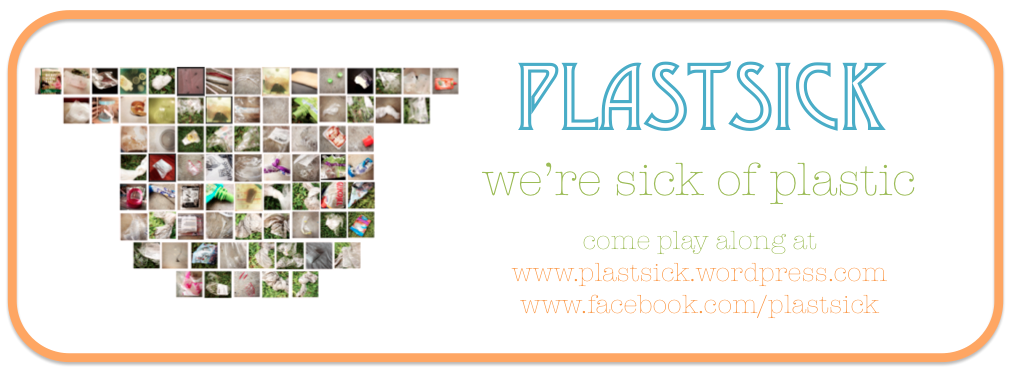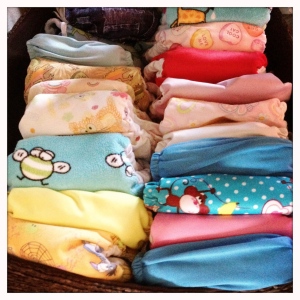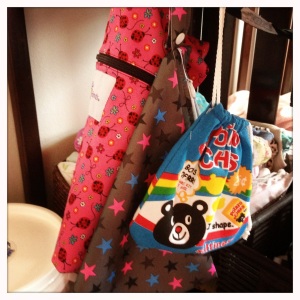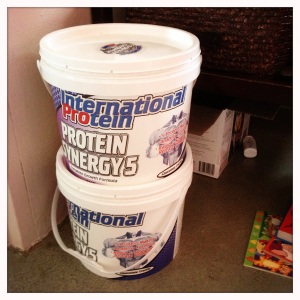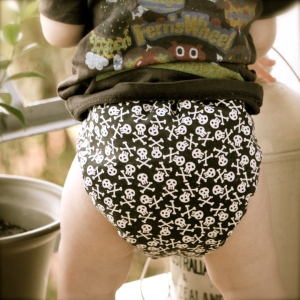There’s a trend here. Even outside of the blog [ie., in my “actual” life], I started to get the feeling like I was an unofficial and unremunerated nappy saleslady. I carted around spare copies of the business card for Nest Nappies, a dedicated cloth nappy store in my hometown of Brisbane. I pocketed a bunch on my last visit because people everyone from the grannies outside Woolies to the teenage mums in the mother’s rooms all started asking me about cloth. Benny tires of the repeated questions we attract as parents of infant twins, but this particular question we welcome.
And then, as I typed off the 4th reply to an [actual] pregnant friend asking me about cloth, and made another coffee date to meet a friend along the Paddington cafe strip and then take them on a visit to Nest Nappies, I realised this blog post was inevitable. So, if you read this post and you like it, well you still have to take me on a coffee date as payment for my advice.
Of course, you can just google or look up some of the information on the advertised brands, but I found my friends were asking about my real learned experience with using cloth nappies. This is just my experience. But I did nappy two babies at once, so yes, I’m an expert.
It’s probably best to start by reading the Why I Cloth post. This, then, is the How. Or the What. For there is an entire cloth nappy vocab to learn.
The Terminology
MCN: Modern Cloth Nappy. They’re shaped like a disposable nappy and do up with velcro or clips.
AIO: All In One. The nappy has no removable parts and does not need to be separated for washing. Usually the insert is sewn into the outer nappy.
AI2: All In Twos. Uh, comes in two parts. It might be a pocket nappy (see below), a nappy with a clipable insert, or an all-absorbent nappy with a pilcher-like cover.
PUL: Polyurethane Laminate. A non-biodegradable but extremely durable waterproof plastic-backed fabric. PUL fabrics are made with funky patterns and are used for the outer covers of MCNs.
Minky: Means a soft fleecy fabric which forms the outer of the nappy. It’s better for overnights as it’s kinder on skin with accumulations of wee.
Pre-Folds: These are usually referring to the old granny style nappies made from towelling fabric. Modern pre-folds though are made of bamboo or other MCN material and can be used as boosters or used on their own with a wet-proof cover.
Pocket Nappy: Means a nappy with an inner liner which is inserted along the body of the nappy. Imagine a super-absorbent cloth panty liner that goes inside your knickers. The liner does not touch the skin, and is removed for washing.
OSFA: One Size Fits All. This term is not particular to cloth nappies, but in this case it means you can use the one nappy from birth until toilet training. Some brands do sized nappies, some are OSFA. Unless you have major fitting issues, I’ve used OSFA and they’ll be cheaper as they will last the whole of your nappying life.
TT: Toilet Training. Der.
China Cheapies: A generic term for nappies purchased on eBay or similar, for around a tenth of the price of the reputable brands.
Bamboo: A fabric made with bamboo fibres. Comes in many different forms, but used a lot in MCNs because it holds moisture very well and is gentle on skin. And it is a more renewable resource than cotton.
Strip Wash: Nappies accumulate soap residue with repeated use, which limits their absorbency. A strip wash helps restore them to brand and spanky new again.
Dry pail: What most nappy brands recommend. Nappies aren’t soaked, just plonk them in a big bin and wait until wash day.
Swim nappy: A reusable cloth nappy they can swim, bathe, and luxuriate in at their local spa.
Inserts: The bits that go in the nappy. It’s a good idea to have extras of these (boosters) to add into the nappy for overnight or if you’re likely to be out for a long time and it won’t be easy to change the nappy.
Liners: You can purchase single-use or reusable liners that go in the nappy (next to bum) to catch stray poos. The idea is that these are then flushed down the loo, or with some brands you can put them through the wash for re-use if you only catch a wee [hats off to my friend Jo for this tip].
The Outlay
Nappy brands charge between $20 and $35 (AUS) for each nappy.
You will need about 15 nappies I reckon.
You can purchase additional absorbent inserts or boosters, and flushable, biodegradable liners.
We should have bought a Little Squirt or something similar, but instead just scraped poo with our hands, or with some toilet paper, or with a spatula. This is not a joke. When the poo is solid enough it just falls into the toilet, but there are many a times it is too soft to lift but too solid to rinse. This device in hindsight would have come in very handy.
You need a good bin with a tight-fitting lid.
Cloth bum wipes are da bomb, but I’d recommend making your own. Blog post to come.
Wet bags made from PUL are a must for the nappy bag.
The Cloth-ing Process
To prepare: You’ll need to sort your nappies out of the wash and with some if they are AI2s you’ll need to construct them together. At a pinch, you can just assemble as you go but I prefer to have them ready to go and they’re neater on the shelf.
To use: I’ve never understood why trashy Rom Coms and suchlike try to make out like nappy changing is some big feat. It couldn’t be easier. Lie baby down, undo the clips, wipe, fold the nappy and place in bin, clip on the new one. Your cloth wipes and wet bags also go into the nappy bin for washing.
To wash: To protect the fabric and extend their life, use the following guidelines.
- Not too hot: About 40 C
- Use half the usual amount of detergent
- No fabric conditioner, bleaching agents, Napisan etc.
To dry: Hanging outside in the sunlight is preferable as the sun bleaches any stains and kills bacteria (it’s true! like magic!).
All of the websites where you can purchase your nappies have a section on nappy care, so it’s worth checking these out.
Where To Get ‘Em
You can order directly through the following websites, or there are heaps and heaps of other online stores nowadays (like EcoBabe and The Nappy Bucket, but really there are too many to mention) which sell a range of products. Baby and kids’ markets are also great places to find smaller and excellent brands. And of course in Brisbane, there’s Nest and Biome.
Here are a few of my favourites for buying online:
And Finally, A Picture Diary
Here is a sample of our personal stash…
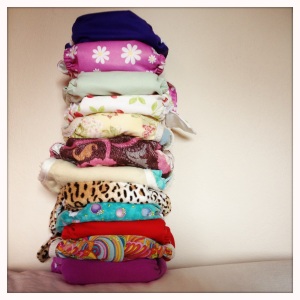
From Top to Bottom: Issy Bear. China cheapy. Pea Pods. Issy Bear. Chloe Toes. Baby BeeHinds. Baby BeeHinds. Issy Bear. Green Kids. China cheapy. Nappylicious. Bubble Bums
And out little soldiers awaiting use under the change table…
Some of our wetbags…
And the upgraded nappy pails. Yes, they are empty protein powder bins, with thanks to our mate Joe who is a semi-professional muscle maniac and passed these on to us. They look ghastly but work better than our original bins.
I think that about *covers* it. Feel free to *leak* this post to others. Using your com*poo*ter please Like and Share! Ok, I’m off to go die now in Bad Pun Land. Hope this makes you all happy nappy chappies!
